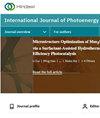二硫化钼薄膜对提高多晶硅太阳能电池性能的影响
IF 2.1
4区 工程技术
Q3 CHEMISTRY, PHYSICAL
引用次数: 1
摘要
本研究工作的重点是借助合成的二硫化钼(MoS2)的抗反射涂层(ARC)来提高多晶硅太阳能电池的功率转换效率。溶胶-凝胶法和电喷雾法是合成MoS2并在太阳能电池表面沉积透明薄膜的首选方法。分析了涂层太阳能电池的光学、电学、结构和热性能,以了解MoS2涂层的影响。用不同的涂覆时间涂覆五个不同的样品(A-II、A-III、A-IV、A-V和A-VI)。其中,120 min涂层样品在阳光直射和钕光下的最大功率转换效率(PCE)分别为17.96%和18.82%,电阻率低至2.79×10−3 Ω−cm。对涂层太阳能电池的光学性能的研究表明,a-IV样品在可见光-紫外光谱中的最大透射率为93.6%,最小反射率为6.3%。样品A-IV在温度分析中显示出显著的结果,在非受控环境中的温度低至38.9°C,在受控源环境中的低至43.2°C。各种分析结果证明,MoS2是一种合适的抗反射涂层材料,可以提高多晶太阳能电池的性能。本文章由计算机程序翻译,如有差异,请以英文原文为准。
Effect of Molybdenum Disulphide Thin Films on Enhancing the Performance of Polycrystalline Silicon Solar Cells
This research work focuses on augmenting the power conversion efficiency of the polycrystalline silicon solar cell with the aid of antireflection coating (ARC) of synthesized molybdenum disulphide (MoS2). The sol-gel technique and electrospraying method were preferred for synthesizing and depositing MoS2 as transparent thin films on the surface of the solar cells. The optical, electrical, structural, and thermal properties of the coated solar cells were analyzed for understanding the influence of the MoS2 coating. Five different samples (A-II, A-III, A-IV, A-V, and A-VI) were coated with varying coating time. Among them, 120 min coated sample experienced a maximum power conversion efficiency (PCE) of 17.96% and 18.82% under direct sunlight and neodymium light with resistivity as low as
2.79
×
10
−
3
Ω
−
cm
. The investigation of optical properties of the coated solar cells revealed a maximum transmittance of 93.6% and minimum reflectance of 6.3%, achieved for A-IV sample in the visible UV spectrum. Sample A-IV showed prominent results in the temperature analysis with temperatures as low as 38.9°C in uncontrolled and 43.2°C in controlled source environments. The results from various analyses proved that MoS2 was an appropriate material for an antireflection coating to enhance the performance of polycrystalline solar cell.
求助全文
通过发布文献求助,成功后即可免费获取论文全文。
去求助
来源期刊
CiteScore
6.00
自引率
3.10%
发文量
128
审稿时长
3.6 months
期刊介绍:
International Journal of Photoenergy is a peer-reviewed, open access journal that publishes original research articles as well as review articles in all areas of photoenergy. The journal consolidates research activities in photochemistry and solar energy utilization into a single and unique forum for discussing and sharing knowledge.
The journal covers the following topics and applications:
- Photocatalysis
- Photostability and Toxicity of Drugs and UV-Photoprotection
- Solar Energy
- Artificial Light Harvesting Systems
- Photomedicine
- Photo Nanosystems
- Nano Tools for Solar Energy and Photochemistry
- Solar Chemistry
- Photochromism
- Organic Light-Emitting Diodes
- PV Systems
- Nano Structured Solar Cells

 求助内容:
求助内容: 应助结果提醒方式:
应助结果提醒方式:


